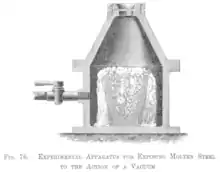Vacuum metallurgy
Vacuum metallurgy is that field of materials technology that deals with making, shaping, or treating metals in a controlled atmosphere, at pressures significantly less than normal atmospheric pressure. [1]The purpose of vacuum metallurgy is to prevent contamination of metal by gases in the atmosphere. Alternatively, in some processes, a reactive gas may be introduced into the process to become part of the resultant product. Examples of vacuum metallurgy include vacuum degassing of molten steel in steelmaking operations, vacuum deposition of thin metal layers in manufacture of optics and semiconductors, vacuum casting, vacuum arc remelting of alloys, and vacuum induction melting.

Early experimental process for treating steel in a vacuum
See also
References
- http://processmaterials.com/technology/vacuum-metallurgy "Vacuum metallurgy", retrieved March 26, 2017
This article is issued from Wikipedia. The text is licensed under Creative Commons - Attribution - Sharealike. Additional terms may apply for the media files.